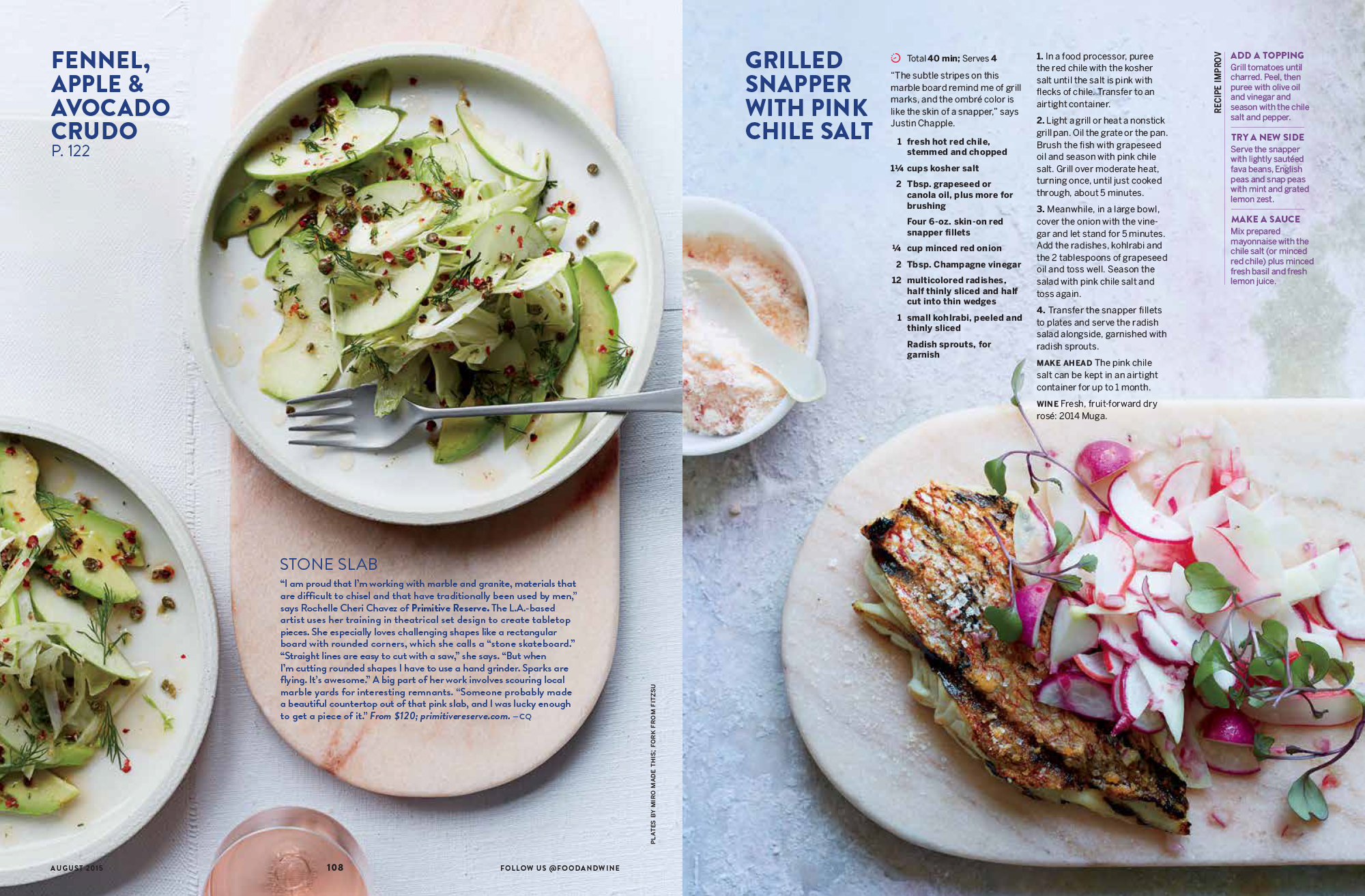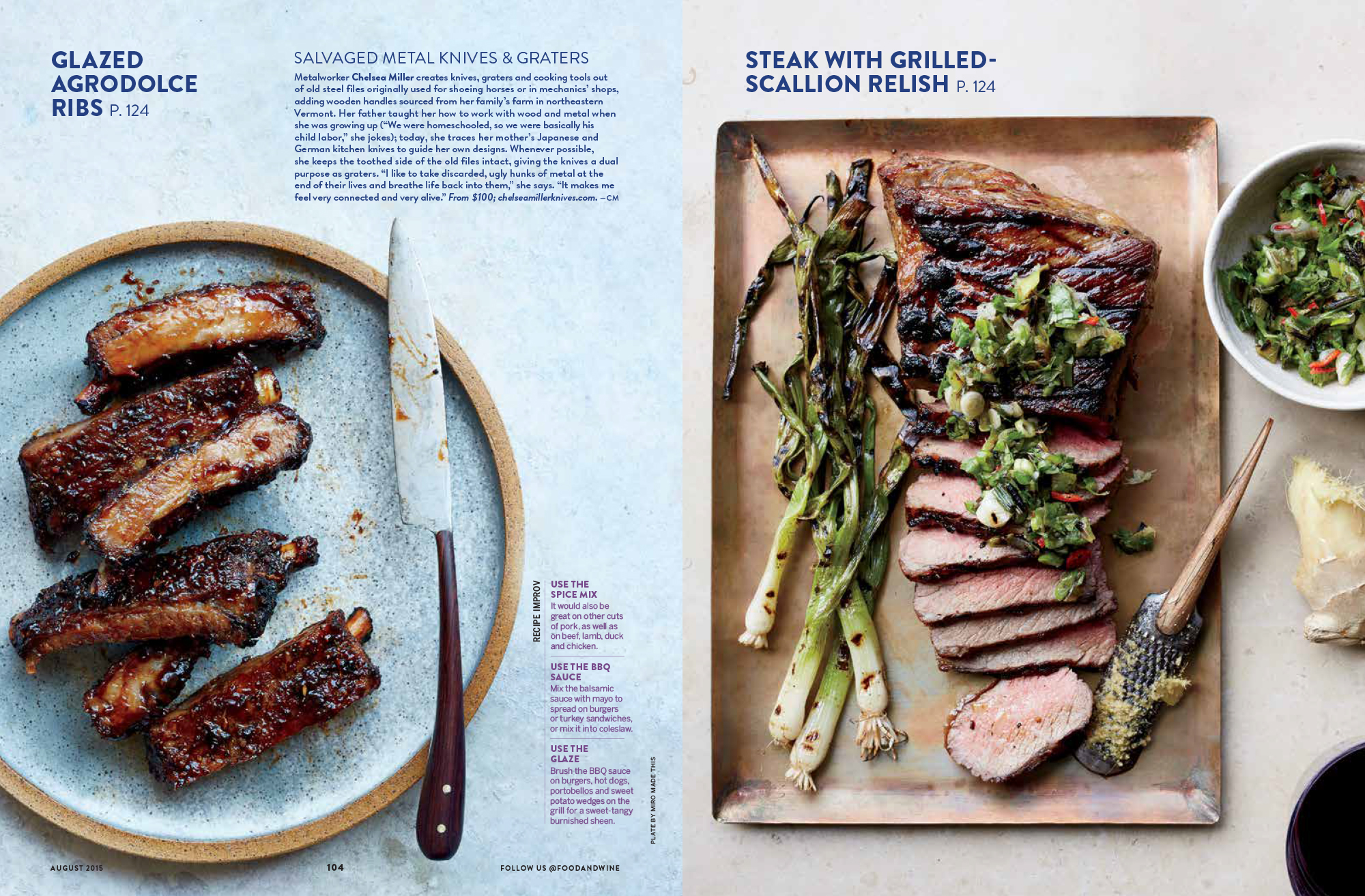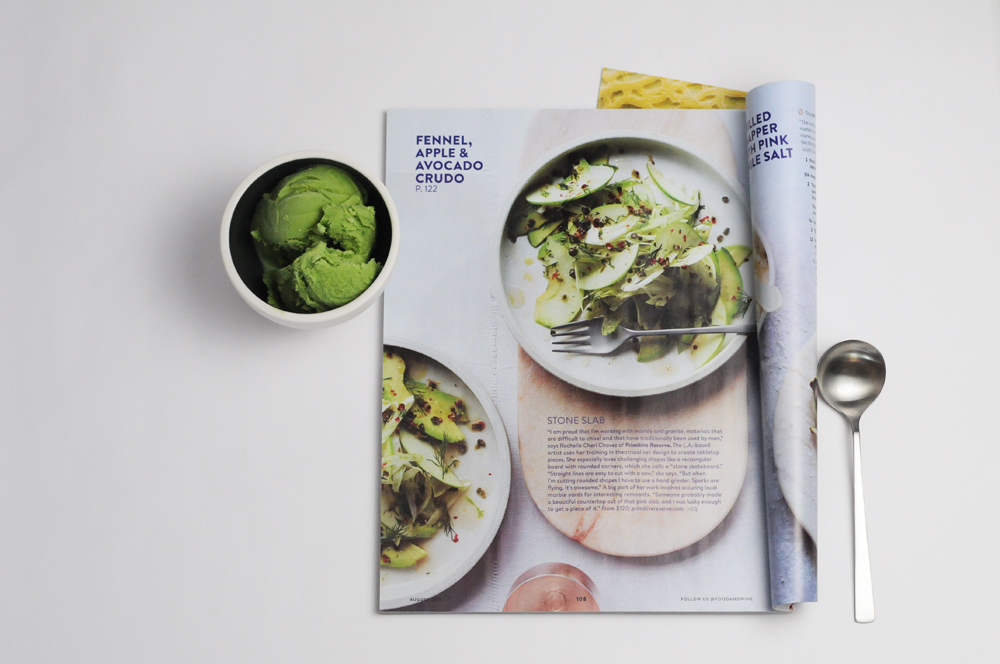Limited Edition for Of A Kind
miro chun
A recent limited edition of Nesting Bowls in Lapis Lazuli blue for Of A Kind! There's also an accompanying article about MMT, and one of my recipes for a fruit galette.
123 Street Avenue, City Town, 99999
(123) 555-6789
email@address.com
You can set your address, phone number, email and site description in the settings tab.
Link to read me page with more information.




A recent limited edition of Nesting Bowls in Lapis Lazuli blue for Of A Kind! There's also an accompanying article about MMT, and one of my recipes for a fruit galette.
Some of my bowls spotted in the July issue of Food&Wine magazine, featuring a dish by Brad Kilgore.
(Photo by Con Poulos, food styling by Simon Andrews, prop styling by Suzie Myers, and art direction by Fredrika Stjarne).
Favorite bit of dialogue from my current guilty pleasure, Orphan Black:
Dr. Leekie: "You know what this is? Synthetic amniotic fluid. We're developing an artificial womb! Bit of a hobby of mine."
Paul: Silence. Then, "I like pottery."
I have a small (but growing) collection of photographs of my work table after having guests to the studio. Invariably when someone visits, pieces get pulled and grouped and rearranged. I like to document what's on the table when the visit ends. Each visitor picks different pieces off the shelves, makes unique groupings—drawing parallels between objects that often I would not have seen. From a single photo I can trace the history of the conversation—shape, size, function, art, architecture, community, and food. I've posted many of these photos on Instagram already, but it's interesting to look at them as a group.
Snapshot of the snapshots
A visit with someone looking for tableware for cookbook photographs, so she was interested in finding clean, minimal pieces that would highlight the ingredients and recipes. She and her husband were also interested in visiting, because they were in the process of taking their first ceramics class. We had met previously once before, just as a way to initiate the conversation—a friend (and her ceramics teacher) had recommended my work to her. I brought a few pieces along so she could see the work in person (she had only seen Instagram photos).
Another photo from the same visit mentioned in the photo above.

A studio visit with someone who had seen my work previously on two occasions, and already owned a few pieces. We looked at a wide range of my work throughout the conversation, but her focus was always on the more neutral, straight-sided, multi-functional serving pieces that would play well with her and her husband's contemporary house and art collection. As we had already established the beginnings of a relationship, the conversation was more about process and other interests, and not solely focused on the pieces at hand, which made for a different rhythm of the visit.

A studio visit with someone looking for holiday gifts. He had never seen any of my work—one of his friends had told him that I was a local ceramicist and that he should take a look. I didn't know his friend, but it turned out that it was one of those six-degrees-of-separation things, and he had actually chatted with my husband before, but not about ceramics. This particular conversation ranged from the pragmatics of ounces and volumes of measure warranted by different coffee brewing styles, to a discussion of how current social situations in the life of a gift recipient change personal dining rituals, and thus the pieces selected.
A studio visit with a couple that I've known for years, including a 2.5 year stint working for them. They were familiar with my work, and had owned pieces for a couple of years. They were focused on selecting demitasse cups, and would have taken what I had in stock, if I had actually had any in stock beyond samples. (Another words, they had come ready to purchase and to use, rather than just browsing—a different mindset and mentality). As the cups were destined for restaurant/coffeeshop usage, part of the discussion centered around how other people would use them, instead of how I, as the maker, or they, as the owners, would use the ceramics.
You would think that if you had 10 people each looking for a teacup the conversation and the parameters around their selections would be the same, or at least very similar. But over the course of these studio visits, it's been enlightening to realize how big a role my relationship to the visitors and their relationship to my ceramics (if they had seen it before, owned pieces, for how long, etc...) has made a difference in both our conversations and their response to my work. And it turn, it's been interesting to see how those same connections have influenced the direction and forms of my practice—the continuing dialogue between the maker and those for whom the maker makes.

Very excited to have an MMT porcelain dinner plate in Food & Wine magazine's May issue, in an article featuring Andrew Zimmern's comfort food recipes.

Food & Wine's March 2016 issue features an article called How To Not, a guide to healthy eating. Miro Made This is thrilled to have our plates coupled with two recipes demonstrating how to use a small amount of meat for flavoring, and focus on vegetables as the mainstay of the meal.
Thought I would use this space to write a little bit about pieces that I make—as a way to offer some insight into my ceramics practice. I'm also hoping to share influences and things I find interesting, but this "Focus" series will be about individual pieces that are the mainstays of my core collection.

Breakfast for us, on the weekends, is something of a sacred ritual. There isn't time during the week, and truthfully, I'm not much of a morning person, so weekend breakfasts are always a chance to relax and reconnect. We usually try to spend at least one of those weekend mornings at home. Breakfast is usually three simple and small courses, setting a leisurely pace that allows me time to prepare between the courses, but also have the chance to sit and enjoy each one. First is fruit (and it's best when it's our own—we grow everything from apricots and peaches to grapes and citrus), and a little yogurt with local honey. The second course is eggs (from our little flock of hens) and sometimes vegetables (also from the garden). And the third course is something a little sweet—either a piece of toast (locally made by one of our baker friends) with some homemade jam, or a little oatmeal.
The oatmeal, of course, is served in an oatmeal bowl. As a matter of fact, almost everything we use on those weekend breakfasts are pieces that I've made over the years—cups (tea for me, espresso for B.), sugar bowls, creamers, salt cellars, plates, small dishes, and bowls.
I seem to (and I suspect most ceramicists also have this) default to a certain size and shape. If I was handed a ball of clay, with no instructions other than to make something, this is the form I would throw. The size and curves would be surprisingly consistent between the pieces, even without the use of a measuring device or guide. I made the first ones long before I had thought about possibly pursing ceramics as a career—at the time it was just a hobby, and a chance to be able to make something fun, that would be both functional and tactile.

There is something very satisfying about holding a small bowl, with an easy curve, in your hands and being able to feel the warmth of the oatmeal through the textured surface of the exposed clay. It's the same curve that comes naturally to the shape of my hands when I'm throwing the bowl on the wheel—a little curved, not so straight and stark, but still as perfect as I can make it.
The bowls actually started out as straight-sided pieces. Back when I was making the first iterations of these, I was obsessed with trying to mimic the straight lines of industrially-machined pieces and get as far away from the "handmade look" as possible. This was indubitably an effect of my perfectionist tendencies, and my architectural training. But handmade pieces aren't really meant to do that. You can force and bully it into straight lines, but the material and the process doesn't work best that way—the material wants to curve and warp and bend throughout the throwing and firing process. And beyond that, even if something does end up straight and perfectly perpendicular to the ground plane, it doesn't necessarily look that way—bowls would look as though they were either flaring out, or angling in. There's a term that everyone learns in architectural history classes—entasis. It refers to the way that Classical greek columns would curve a little—just enough to appear straight. I think there's a little bit of that in the oatmeal bowls. But also curves are more forgiving, a little more organic, and for something like oatmeal, or soup, or whatever you choose to use them for—there's something appealing about how the slight curvature emphasizes the way you want to cup something tasty that you're about to consume. The same process of refining the angle where the bowl closes in to the finish of the foot also developed that way—through use, observation, and refinement over the years as the pieces were folded into our daily lives.
Of course, you can use the bowl for other things. I have a friend that drinks vast amounts of tea, and he feels that this size and proportion is closer to what he wants to be able to drink his tea in. I'm working on another variation that's a little more angled and a little more rounded to use as a proper teabowl, since the shape is close. I've also made a range of lids for the bowls, to let them stack in another way, and be used for other things. I've made panna cotta in them, and filled the shallow indent of the lid with fresh berries or placed a small crumbly cookie on top to have with the unctuous smoothness of the dessert. If I'm serving soup, the lid is helpful for keeping things warm and steaming inside, or alternatively, to protect the contents from pesky insects (or curious chickens) when we choose to eat outside at the picnic table. I store things in them—cough drops by my bedside when I'm sick, or one of multiple headphones in the studio. I have friends that use them as sugar jars for the table, or to store garlic and shallots on the kitchen counter. The list goes on. It is always nice to hear how the pieces are being used—what maker doesn't want to know that their creations have become cherished pieces in other people's daily rituals?
I think one of the key reasons that the oatmeal bowl is a favorite is because I've lived with it for a long time—it's one of the pieces that we use at home, and that will continue to live in our cupboards and on the dining table. My process is not fast—I like to think through things, make pieces, and then live with them for a while. The long history allows for changes and refinements, as only years of use and handling and "looking at" will provide the opportunity to happen. It is a chance to make and remake, and is one of the best parts of doing what I do—the ceramics process doesn't stop just when the piece is glazed and fired, it continues through the life of the pieces and those that use it.

Various lid variations, and older, straight sided piece second from the right.

Oatmeal bowl lids that double as small dishes


Food & Wine's September issue features a profile on chef Enrique Olvera's Mexico City inspirations. A Miro Made This plate provided the perfect setting for his visually arresting Cornhusk Meringues with Corn Mousse. Additional MMT tableware is featured in The Gastronaut Files.



It's been 110 degrees here in the Phoenix desert, but the coolest thing to happen this summer has been the arrival of the August issue of Food & Wine magazine—on stands now! Miro Made This is thrilled to have our work featured alongside a shortlist of other American artisans producing hand-crafted goods for the table.